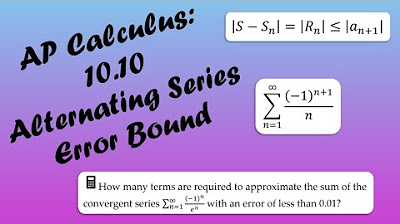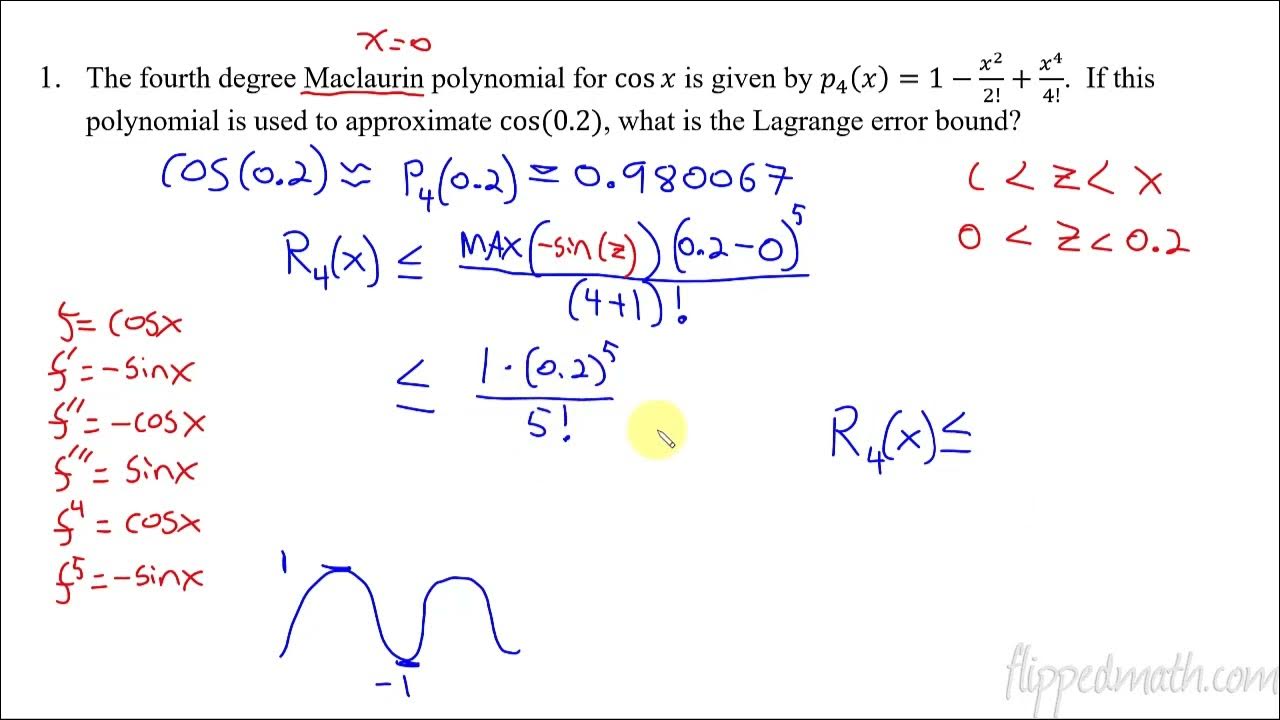Estimating the Remainder of a Series Approximation via the Integral Test
TLDRThe video script delves into the concept of series convergence, focusing on the nth partial sum and the remainder term. It introduces a method to estimate the remainder's size using integral tests, demonstrating how to bound the remainder between two inequalities. The script uses the series 1/n^3 as an example to show how to compute the 10th partial sum and estimate the remainder, revealing the importance of the remainder in determining the accuracy of series approximations for various applications.
Takeaways
- 📚 The script discusses the concept of series and partial sums, emphasizing the importance of the nth partial sum in determining the convergence of a series.
- 🔍 It introduces the term 'remainder' (R sub N) as the part of the series beyond the nth term, which is crucial for understanding the approximation of a series' sum.
- 📉 The script explains how to use summation notation to represent the nth partial sum and the remainder of a series.
- 📈 The integral test is related to the concept of remainders in series, and the script uses it to provide bounds for the remainder term.
- 📝 The script provides a method to estimate the remainder by comparing it to the area under a curve, using rectangles with right and left endpoints to define the height.
- 📊 By using the right endpoint rectangles, the remainder is less than the improper integral from n to infinity, providing an upper bound for the error term.
- 📐 Conversely, using left endpoint rectangles gives a lower bound for the remainder, as it makes the rectangles larger and thus the series greater than the integral.
- 🧩 The script illustrates how the remainder term is 'squeezed' between two bounds, providing an estimate of its size.
- 🌐 It uses the example of the series 1/n^3 to demonstrate how to compute the nth partial sum and estimate the remainder using the integral test.
- 🔢 The script shows how to use Wolfram Alpha to compute the 10th partial sum of the series 1/n^3, obtaining an approximate value.
- 📊 The example also demonstrates how to calculate the bounds of the remainder using the integral of 1/x^3 from 10 to infinity, providing an error estimate.
- 🔑 The script concludes by highlighting that adding more terms to the series can improve the accuracy of the approximation, and the method can be used to achieve any desired level of precision.
Q & A
What is the nth partial sum in the context of the series discussed in the script?
-The nth partial sum refers to the sum of the first n terms of a series. It is important in determining whether a series converges to a specific value L, as the limit of the partial sums approaching L indicates convergence.
What is meant by the 'remainder' in the series discussed in the script?
-The 'remainder' is the part of the series that extends from the (n+1)th term to infinity, denoted as R sub N. It represents the difference between the infinite series and its nth partial sum.
How can the remainder of a series be represented using summation notation?
-The remainder can be represented using summation notation as the sum from n+1 to infinity of the terms of the series, which is the entire series minus the nth partial sum.
What is the significance of the error term in the context of series convergence?
-The error term, or remainder, is significant because it helps to estimate how close the nth partial sum is to the actual value that the series converges to. It provides a measure of the approximation error when using a finite number of terms to estimate the series sum.
How does the script relate the concept of series convergence to the integral test?
-The script relates the concept of series convergence to the integral test by considering a function f(x) that corresponds to the terms of the series. The integral from n to infinity of f(x) dx gives an upper bound for the remainder of the series, which helps in estimating the convergence behavior.
What is the purpose of using rectangles with right endpoints in the script's explanation?
-Using rectangles with right endpoints helps to define the height of the rectangles as the terms of the series from n+1 onwards. The area under these rectangles represents an upper bound for the remainder of the series, providing an estimate of the convergence error.
How does changing to left endpoints for the rectangles affect the estimation of the remainder?
-Changing to left endpoints for the rectangles makes the rectangles larger, which in turn provides a lower bound for the remainder of the series. This gives another inequality that helps to bound the remainder from below.
What is the example series given in the script, and how is its convergence determined?
-The example series is the sum from 1 to infinity of 1/n^3. Its convergence is determined by relating it to a p-series with p=3, which is greater than 1, indicating that the series converges.
How does the script use Wolfram Alpha to compute the 10th partial sum of the example series?
-The script uses Wolfram Alpha as a powerful computational tool to calculate the 10th partial sum of the series by inputting the sum from 1 to 10 of 1/n^3 and obtaining the approximate value of 1.196.
What is the estimated remainder when using the 10th partial sum of the example series?
-The estimated remainder when using the 10th partial sum is less than 1/200, which is approximately 0.005. This provides an upper bound for the error in the approximation.
How can the accuracy of the series approximation be improved according to the script?
-The accuracy of the series approximation can be improved by computing more terms, such as the 100th, 1000th, or even the billionth partial sum, which would result in a smaller remainder and a more accurate estimate.
Outlines
📚 Understanding Series Convergence and Remainder Terms
This paragraph introduces the concept of series convergence, focusing on the nth partial sum and the remainder term. It explains how the series is written in a detailed manner, emphasizing the importance of the nth partial sum in determining convergence. The remainder term, denoted as R sub N, is introduced as the difference between the series and the nth partial sum. The paragraph also discusses the significance of estimating the remainder to understand the accuracy of the approximation when only a finite number of terms are summed. The integral test is mentioned as a method to estimate the remainder, by comparing the area under a continuous, decreasing function to the sum of the series terms.
📉 Applying the Integral Test to Estimate Remainder Terms
The second paragraph delves into the application of the integral test to estimate the remainder term of a series. It uses the example of the series sum of 1/n^3 from 1 to infinity, which is known to converge based on the p-series test. The paragraph explains how to compute the 10th partial sum using a tool like Wolfram Alpha, obtaining an approximate value of 1.196. It then demonstrates how to calculate the upper bound of the remainder by integrating the function from n=10 to infinity, resulting in an error estimate of less than 0.005. The discussion highlights the importance of adding more terms for a more accurate approximation and the method's flexibility in achieving the desired level of precision.
Mindmap
Keywords
💡Series
💡Convergence
💡Partial Sum
💡Remainder
💡Integral Test
💡Function f(x)
💡Rectangles
💡Bounds
💡Error Term
💡Wolfram Alpha
💡Improper Integral
💡Power Rule
Highlights
Introduction to the concept of an infinite series and its nth partial sum.
Explanation of series convergence in terms of the limit of partial sums approaching a limit L.
Introduction of the 'remainder' term, R sub N, representing the infinite tail of the series after the nth term.
Use of summation notation to express the nth partial sum and the remainder.
Discussion on the importance of the remainder term in estimating the closeness of a partial sum to the series' convergence value.
Relation of the series remainder to the integral test and bounding the remainder using integrals.
Graphical representation of the series using rectangles to visualize the area corresponding to the series terms.
Use of right and left endpoints to define the height of rectangles for bounding the remainder term.
Derivation of inequalities to bound the remainder term between two integrals.
Application of the method to estimate the remainder and its impact on the accuracy of the series approximation.
Example calculation using the series sum of 1/n^3 from 1 to infinity, demonstrating the convergence and estimation process.
Utilization of Wolfram Alpha for computing the 10th partial sum of the series 1/n^3.
Explanation of how to compute the improper integral to bound the remainder for the series 1/n^3.
Analysis of the remainder term's impact on the accuracy of the approximation, given the computed 10th partial sum.
Discussion on the trade-off between the number of terms computed and the accuracy of the series approximation.
Highlighting the flexibility of the method to achieve any desired level of accuracy by computing more terms.
Conclusion on the practicality of the method for various applications and the importance of understanding the remainder term.
Transcripts
Browse More Related Video

Worked example: alternating series remainder | Series | AP Calculus BC | Khan Academy

Alternating series remainder | Series | AP Calculus BC | Khan Academy

AP Calculus BC Lesson 10.10

Calculus BC – 10.12 Lagrange Error Bound

Integral Test as Estimation | MIT 18.01SC Single Variable Calculus, Fall 2010

Series estimation with integrals | Series | AP Calculus BC | Khan Academy
5.0 / 5 (0 votes)
Thanks for rating: